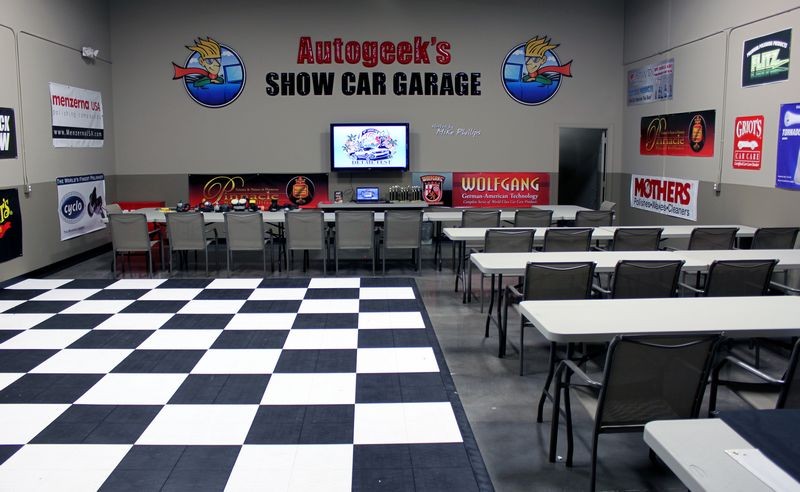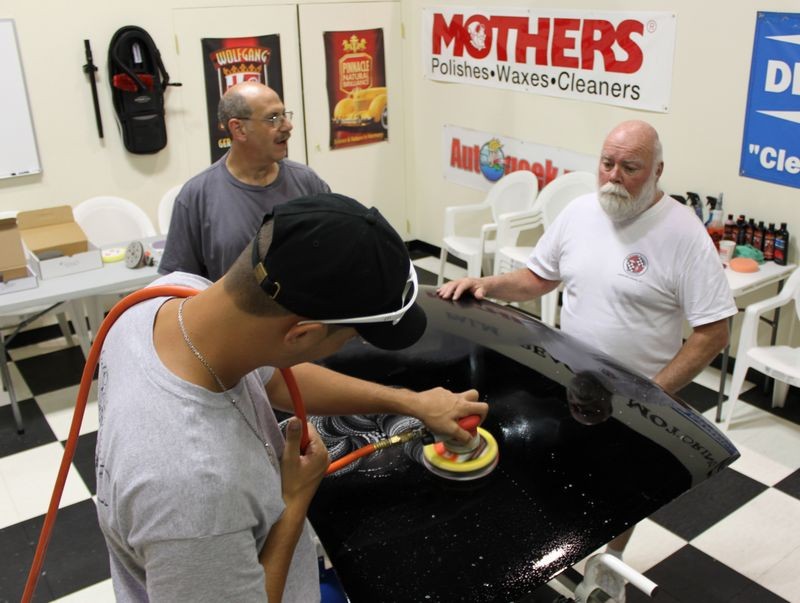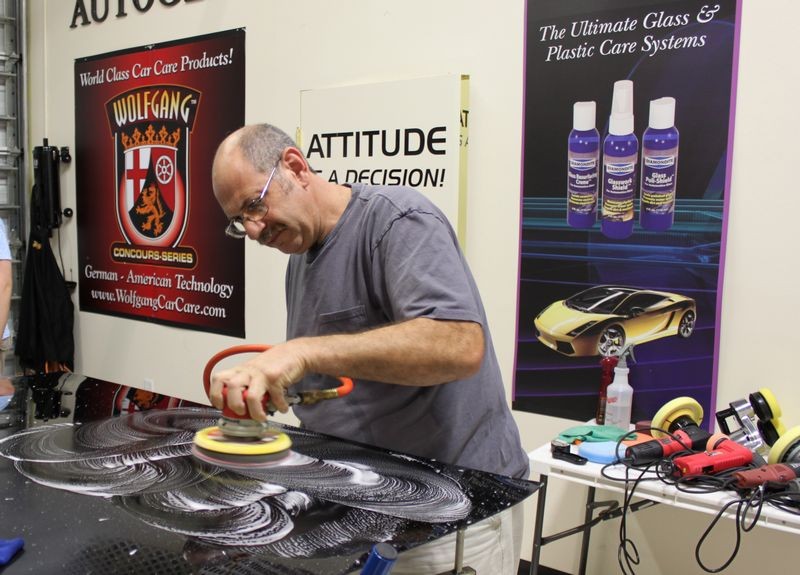Mike Phillips
Active member
- Dec 5, 2022
- 51,004
- 6
Can an air-powered DA Sander be used to polish paint?
Recently a new member asked the above question and because the question comes up often enough on this forum, the question and and answer qualify to have their own dedicated thread here in our "Hot Topics and Frequently Asked Questions" forum group.
Note, this wasn't an in-depth study, just some quick side-by-side testing I did on-the-fly on a Saturday afternoon after finishing some other projects like the Flits metal polishing project using the brass boat propeller seen below.

On to the testing...
First, the air-compressor I'm using is a large Ingersoll Rand unit and it's able to easily maintain 100 psi air flow to the sander.
Ingersoll Rand Air Compressor

This shot taken immediately after running the sander...

From left to right...
3M 3/16 12,000 RPM RO Sander with 5" Backing Plate with 5.5 Surbuf MicroFinger Buffing Pad
3M 3/16 12,000 RPM RO Sander with 6" Backing Plate with 6.5" CCS Orange Light Cutting Pad
Dynabrade 3/16 10,000 RPM RO Sander with 6" Backing Plate with 6.5 Surbuf MicroFinger Buffing Pad

Between the 3M unit and the Dynabrade Unit, the 3M DA Sanger had more power or a better way of describing it would be to say that it was better able to keep a pad rotating under pressure.
This is key for the correction step because it's when the pad is rotating that paint is being removed and thus defects are being removed.
The two 3M DA Sanders are identical and we will be stocking these units.
6.6" Pad Test
I tested 6.5" foam pads and 6.5" Surbuf MicroFinger Pads using 6" backing plates.
With the air throttle wide open and with firm to extreme downward pressure I could not stop the Surbuf pad from rotating when the pad was held flat and when the pad was held on edge.
With the air throttle wide open and with firm to extreme downward pressure I was able to stop the foam pad from rotating both when the pad was held flat and on edge.
5.5" Pad Test
With the air throttle wide open and with firm to extreme downward pressure I could not stop the Surbuf pad from rotating when the pad was held flat and when the pad was held on edge.
With the air throttle wide open and with firm to extreme downward pressure it was very difficult to stop the foam pad from rotating both when the pad was held flat and on edge.
Summary
If you want to use a air-powered DA Sanger to remove swirls and scratches then stick with the 5.5" pads either foam or Surbuf Microfiber pads and you should be able to tackle most of what comes you're way.
The 6.5" Surbuf MicroFinger pads worked on both the 3M DA Sander and the Dynabrade DA Sander but the 3M unit did do a better job of keeping the pads rotating.
You can use 6.5" foam pads with the air-powered DA sanders but to keep the pad rotating you can't push as hard and you really have to focus on keeping the pads held flat to the surface.
My comments...
I was really impressed with the rotating ability of the Surbuf Microfiber pads when used on both of these air powered DA Sanders. To date, I've found the Surbuf Microfiber pads are best suited for correction work, that is removing defects as they can leave behind tick marks, or micro-marring like foam cutting pads can leave behind on some paints. So plan on following any correction steps with MicroFinger buffing pads with another polishing step using either a foam polishing or foam finishing pad and a light cutting polish.
Product showcased
3M Air Powered DA Sander - Coming soon...
Surbuf R Series 4 Inch Buffing Pads 2 Pack
Surbuf R Series 5.5 Inch Buffing Pads 2 Pack
Surbuf R Series 6.5 Inch Buffing Pads 2 Pack
6.5" CCS Foam Pads
5.5" CCS Foam Pads
5.5" Flat Foam pads
6.5 Flat Foam Pads
5.5" Hydro-Tech Pads
6.5" Hydro-Tech Pads
See also...
Surbuf MicroFinger Buffing Pads now at Autogeek!
List of Sanding Discs at Autogeek.net

Copyright ©PBMA - AutogeekOnline.net® All Rights Reserved
Recently a new member asked the above question and because the question comes up often enough on this forum, the question and and answer qualify to have their own dedicated thread here in our "Hot Topics and Frequently Asked Questions" forum group.
Note, this wasn't an in-depth study, just some quick side-by-side testing I did on-the-fly on a Saturday afternoon after finishing some other projects like the Flits metal polishing project using the brass boat propeller seen below.

On to the testing...
First, the air-compressor I'm using is a large Ingersoll Rand unit and it's able to easily maintain 100 psi air flow to the sander.
Ingersoll Rand Air Compressor

This shot taken immediately after running the sander...

From left to right...
3M 3/16 12,000 RPM RO Sander with 5" Backing Plate with 5.5 Surbuf MicroFinger Buffing Pad
3M 3/16 12,000 RPM RO Sander with 6" Backing Plate with 6.5" CCS Orange Light Cutting Pad
Dynabrade 3/16 10,000 RPM RO Sander with 6" Backing Plate with 6.5 Surbuf MicroFinger Buffing Pad

Between the 3M unit and the Dynabrade Unit, the 3M DA Sanger had more power or a better way of describing it would be to say that it was better able to keep a pad rotating under pressure.
This is key for the correction step because it's when the pad is rotating that paint is being removed and thus defects are being removed.
The two 3M DA Sanders are identical and we will be stocking these units.
6.6" Pad Test
I tested 6.5" foam pads and 6.5" Surbuf MicroFinger Pads using 6" backing plates.
With the air throttle wide open and with firm to extreme downward pressure I could not stop the Surbuf pad from rotating when the pad was held flat and when the pad was held on edge.
With the air throttle wide open and with firm to extreme downward pressure I was able to stop the foam pad from rotating both when the pad was held flat and on edge.
5.5" Pad Test
With the air throttle wide open and with firm to extreme downward pressure I could not stop the Surbuf pad from rotating when the pad was held flat and when the pad was held on edge.
With the air throttle wide open and with firm to extreme downward pressure it was very difficult to stop the foam pad from rotating both when the pad was held flat and on edge.
Summary
If you want to use a air-powered DA Sanger to remove swirls and scratches then stick with the 5.5" pads either foam or Surbuf Microfiber pads and you should be able to tackle most of what comes you're way.
The 6.5" Surbuf MicroFinger pads worked on both the 3M DA Sander and the Dynabrade DA Sander but the 3M unit did do a better job of keeping the pads rotating.
You can use 6.5" foam pads with the air-powered DA sanders but to keep the pad rotating you can't push as hard and you really have to focus on keeping the pads held flat to the surface.
My comments...
I was really impressed with the rotating ability of the Surbuf Microfiber pads when used on both of these air powered DA Sanders. To date, I've found the Surbuf Microfiber pads are best suited for correction work, that is removing defects as they can leave behind tick marks, or micro-marring like foam cutting pads can leave behind on some paints. So plan on following any correction steps with MicroFinger buffing pads with another polishing step using either a foam polishing or foam finishing pad and a light cutting polish.
Product showcased
3M Air Powered DA Sander - Coming soon...
Surbuf R Series 4 Inch Buffing Pads 2 Pack
Surbuf R Series 5.5 Inch Buffing Pads 2 Pack
Surbuf R Series 6.5 Inch Buffing Pads 2 Pack
6.5" CCS Foam Pads
5.5" CCS Foam Pads
5.5" Flat Foam pads
6.5 Flat Foam Pads
5.5" Hydro-Tech Pads
6.5" Hydro-Tech Pads
See also...
Surbuf MicroFinger Buffing Pads now at Autogeek!
List of Sanding Discs at Autogeek.net







